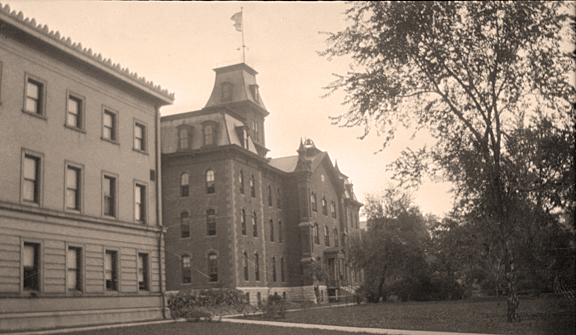
With the completed demolition of Ferguson Hall, university officials are moving forward with a plan to honor University Hall, the first building on campus.
Ferguson Hall was demolished this summer after physics and astronomy faculty and staff moved into the newly constructed Jorgensen Hall. Read more about Jorgensen Hall at http://www.unl.edu/scarlet. A video tour of Jorgensen is available at http://go.unl.edu/gzb.
The Ferguson Hall site - positioned between Brace Labs, Woods, Richards and Manter halls - will be converted into a green space with a seating area.
"The entire area is being designed to honor University Hall," said Eileen Bergt, director of Landscape Services. "The space will include a curved seating area, facing south and located near what we believe to be the original entrance to University Hall. There will also be historical information, including the Nebraska Historical Society plaque that was already in the area."
Bergt said professors Kay Logan-Peters (University Libraries) and Peter Bleed (anthropology) helped identify the original location of University Hall.
"There aren't a lot of pictures or drawings to show the relationship between University Hall and other buildings on campus," Bergt said. "But, we think we're pretty close."
The image at right shows University Hall as it stood next to the southeast corner of Brace Labs. The photo is courtesy of the University Archives.
Construction of University Hall began in 1869 and the building opened to classes in fall 1871. The three-story structure included a full basement, a mansard roof, large central tower, chapel and a bell.
The construction was difficult because there was no railroad line into Lincoln. Lumber was hauled by wagon from the Nebraska City area, cord wood to fire the brick was also hauled miles. A local brick shortage compounded problems. And, in 1870, three men died in a construction accident.
University Hall was constructed with local limestone and common brick. Parts or all of the foundation were repaired or entirely replaced in 1871, 1873 and 1877.
The original tin roof leaked from the beginning and was replaced with a slate roof in 1883. The slate added extra weight to an already strained foundation and walls. By 1916, the walls had shifted and a series of steel rods were added as reinforcement. In 1925, the top two stories were removed. The building was razed in 1948, making room for Ferguson Hall.
Despite the problems that plagued University Hall, it was fondly remembered by students and faculty. The bell is now a part of the garden at the Wick Alumni Center. And, a model of University Hall was given to the university by the class of 1897. The model is housed at University Facilities Management.
For more information on University Hall and Ferguson Hall, go to http://historicbuildings.unl.edu.
Bergt said plans for the green space and seating area are being finalized, with construction to begin this fall.
- By Troy Fedderson, University Communications